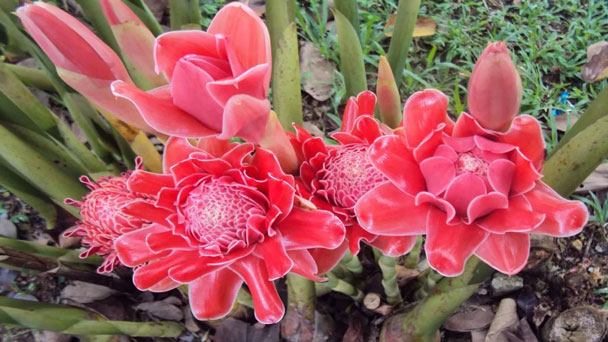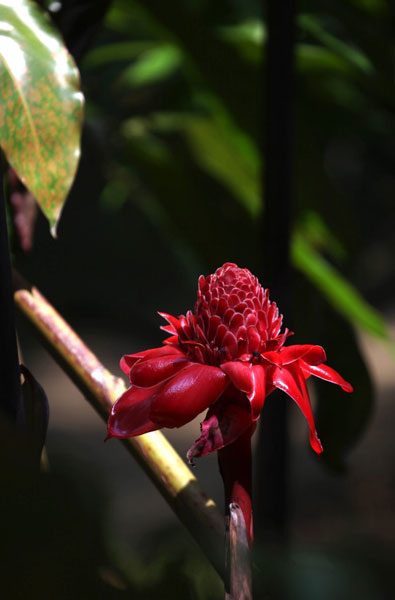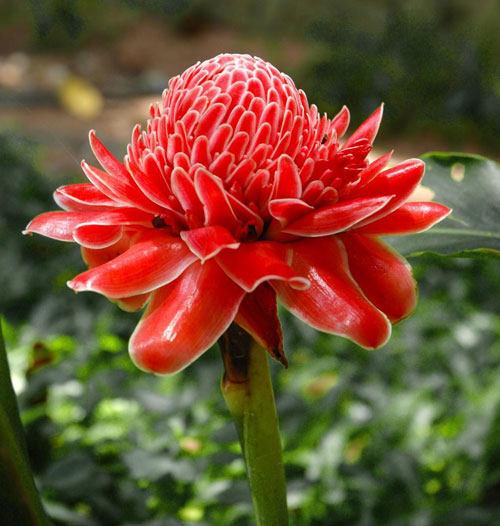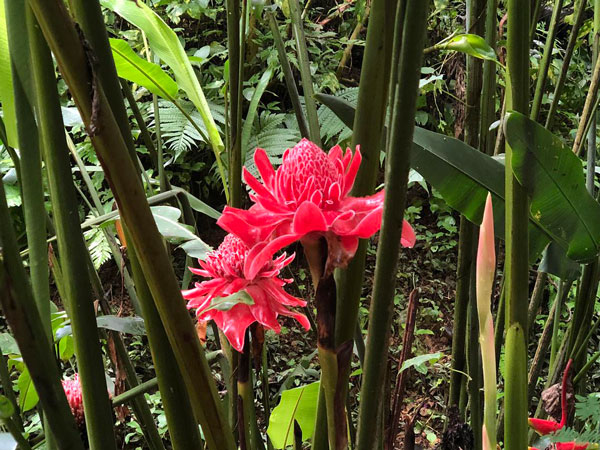Torch Ginger: Grow & Care for Etlingera Elatior
Written by Iris
Sep 18 2021

Torch ginger (etlingera elatior) is a perennial herb, originating in Africa, South America, Mexico, Asia, the Philippines, Malaysia and other places. The flower color of Torch Ginger (Etlingera elatior) is beautiful and the flower shape is graceful; the flower is like a fiery red lotus; if the flowers are all open, with the size of a bowl, it is an excellent variety of cut flowers. The flower can be bloomed and picked one year after planting, and the flowering period is longer, up to one to two months. At the same time, because of its thick bract leather, strong water-holding capacity, and not easy to lose water, it has a long fresh-keeping time and can be kept for half a month under conventional conditions. In addition, porcelain roses can also be used as large potted plants for indoor viewing.
Before sowing, you should soak the plant seeds in warm water overnight.
To plant successfully, dig a 3/4″ inch hole for each seed you wish to plant.
The holes should be spaced 6′ feet apart.
After dropping the seed in the hole, cover it lightly with rich, loose soil.
Water thoroughly and maintain constant moisture until your seeds have sprouted and become established.
Once established, these plants will self propagate easily through spreading rhizomes.
The rhizomes can then be divided annually to further propagation.
Plant the offshoots in individual containers filled with perlite or vermiculite. Lift the offshoots out of the containers periodically to check the roots. If the roots look developed, strong and healthy, plant the torch gingers in the ground.
Water. torch ginger plants prefer consistently moist soil but not persistently soggy conditions. They can tolerate being waterlogged for a short time, but eventually this will cause root rot. Plan to water whenever the top 1 to 2 inches of soil has dried out, especially during the warmest months of the year.
‘Yamamoto’: This plant is notably tall and features large light pink blooms.
‘Giant Red Torch Ginger’: This variety can grow to 20 feet tall and blooms with bright red flowers.
‘White Torch Ginger’: This rare plant features large white blooms with hints of yellow.
‘Borneo Pink Torch Ginger’: This is another rare plant with pink blooms and red to maroon leaves.
‘Sunset Red Torch Ginger’: This rare plant has red blooms and leaves that are dark green on top and reddish-purple underneath.
In places such as Hawaii, Costa Rica, and China, where it has been introduced and cultivated as an ornamental flower, it has become quite invasive.
Torch Ginger spreads readily through rhizome division and also seed distribution.
In many tropical areas with consistently moist conditions, it has grown into dense thickets that force out native plants.
If you live in a tropical or semi-tropical setting, you should keep a close eye on this plant and make sure it stays contained in your garden.
How to Grow Torch Ginger (Etlingera elatior)Torch Ginger Propagation with SeedsTorch Ginger Propagation with OffshootsHow to Care for Torch Ginger (Etlingera elatior)LightSoilTemperature and HumidityFertilizerPruningVarieties of Torch Ginger (Etlingera elatior)Torch Ginger (Etlingera elatior) FAQIs The Ginger Plant Toxic Or Poisonous?Is This Ginger Invasive?
How to Grow Torch Ginger (Etlingera elatior)
Torch Ginger Propagation with Seeds
To get started with etlingera elatior, direct sow the seeds into your garden soil in a partially shaded area where you have tested the soil’s pH and potassium levels.Before sowing, you should soak the plant seeds in warm water overnight.
To plant successfully, dig a 3/4″ inch hole for each seed you wish to plant.
The holes should be spaced 6′ feet apart.
After dropping the seed in the hole, cover it lightly with rich, loose soil.
Water thoroughly and maintain constant moisture until your seeds have sprouted and become established.
Once established, these plants will self propagate easily through spreading rhizomes.
The rhizomes can then be divided annually to further propagation.
Torch Ginger Propagation with Offshoots
Torch gingers produce shoots, called inflorescences, that emerge from the ground protected by bracts. Each bract contains offshoots that you can use to propagate a new torch ginger plant. Gingers propagated via offshoots need two years to start bearing flowers. For offshoot propagation, fill a container with potting soil and bend the flower head into the container. Cover the flower with soil. In a few weeks, the offshoots will grow roots. At this time, remove the offshoots from the mother torch ginger by cutting them off at their base. The base is the part of the offshoot closest to the bracts of the mother flower.Plant the offshoots in individual containers filled with perlite or vermiculite. Lift the offshoots out of the containers periodically to check the roots. If the roots look developed, strong and healthy, plant the torch gingers in the ground.

How to Care for Torch Ginger (Etlingera elatior)
Light
Torch Ginger likes to be placed in a partially shaded setting sheltered from high winds. It’s good to choose a setting shaded by a building or by shade trees for several hours daily to prevent excessive exposure to harsh sunlight. Ginger flowers thrive in bright locations with some direct sun. Red ginger makes a stunning floor plant in front of a sunny window. Turn the pot each week to give each side equal light exposure.Soil
Ginger grows well in rich soil and in wet habitats, but it can grow in dry areas as well. Red ginger grows best in fertile, organically rich, moist, well drained soils with a pH range of 6.0 to 6.8. In poorly drained clay soils, chlorosis attributed to high manganese content may occur. Chlorosis due to high pH in calcareous soils is a common problem.Water. torch ginger plants prefer consistently moist soil but not persistently soggy conditions. They can tolerate being waterlogged for a short time, but eventually this will cause root rot. Plan to water whenever the top 1 to 2 inches of soil has dried out, especially during the warmest months of the year.
Temperature and Humidity
Average room temperatures 65-75°F/18-24°C. If you scoot your container to the patio or porch for the summer, don't worry -- it can take the heat. But bring it back indoors when the temperature drops...these tender perennials will only tolerate temps as low as 50°F/10°C. Give tropical Alpinia purpurata as high humidity as you can indoors -- 50% relative humidity is ideal. It's a good idea to use a cool-mist room humidifier near the plant, if the air is dry.Fertilizer
Apply a complete fertilizer once a month. Flower production increases with increasing levels of nitrogen fertilizer. High levels of nitrogen fertilizer do not adversely affect the postharvest life of the flowers.Pruning
Prune a broken shoot off a torch ginger at the point of origin on the main stalk. If you have several broken shoots, make the pruning cut a few inches below the broken area. Cutting too many broken shoots back to the main stalk will make a torch ginger very thin.
Varieties of Torch Ginger (Etlingera elatior)
Torch ginger is available in varieties primarily based on its flower color, including:‘Yamamoto’: This plant is notably tall and features large light pink blooms.
‘Giant Red Torch Ginger’: This variety can grow to 20 feet tall and blooms with bright red flowers.
‘White Torch Ginger’: This rare plant features large white blooms with hints of yellow.
‘Borneo Pink Torch Ginger’: This is another rare plant with pink blooms and red to maroon leaves.
‘Sunset Red Torch Ginger’: This rare plant has red blooms and leaves that are dark green on top and reddish-purple underneath.

Torch Ginger (Etlingera elatior) FAQ
Is The Ginger Plant Toxic Or Poisonous?
Torch Ginger is non-toxic and has a great many uses in the kitchen and in medicine. Its stems are often sliced thin and used in soups and curries. The flowers may also be used in cold dishes, such as salads. Studies have found various aspects of the plant can help reduce heavy metal toxicity, scavenge free radicals in the blood, and deliver a number of other protective and healing benefits.Is This Ginger Invasive?
In the contiguous United States, this plant is easy to grow in semi-tropical settings and then does not have as much weed potential as it does in truly tropical settings.In places such as Hawaii, Costa Rica, and China, where it has been introduced and cultivated as an ornamental flower, it has become quite invasive.
Torch Ginger spreads readily through rhizome division and also seed distribution.
In many tropical areas with consistently moist conditions, it has grown into dense thickets that force out native plants.
If you live in a tropical or semi-tropical setting, you should keep a close eye on this plant and make sure it stays contained in your garden.
Latest Updated
- Benefits of Bugleweed - 7 Science-backed Health Benefits
- Bugleweed Dangers & Side Effects - Is It Poisonous?
- How to Plant Evergreen Trees - What You Should Know
- When to Plant Evergreens - Grow Guide for Evergreen Trees
- 12 Wonderful Evergreen Shrubs for Your Garden
- 12 Popular Evergreen Plants with Pictures for Beginners
- When And How To Prune A Lilac Bush Like a Pro
- How to Grow & Care for Lilac Vine (Hardenbergia Violacea)
- Japanese Lilac Tree (Syringa Reticulata) Care & Propagation Guide
- Shumard Oak Pros and Cons - What to Know
Popular Articles
- Winter maintenance of Antirrhinum Majus
- How to Grow Terminalia Mantaly Tree
- How to Grow and Care for Crossostephium Chinense
- How to grow Antirrhinum Majus in spring
- Peristeria Elata (Dove Orchid) Profile: Info & Care Guide
- Underwatered Snake Plant (Sansevieria Trifasciata) - Signs And How To Fix
- How to Care for Brazilian Jasmine Plant (Mandevilla Sanderi)
- How to Grow & Care for Graptopetalum Purple Delight in Summer
- Rosa Chinensis (China Rose): Plant Growing & Care Tips
- How to Care for Baby Sun Rose (Aptenia Cordifolia)